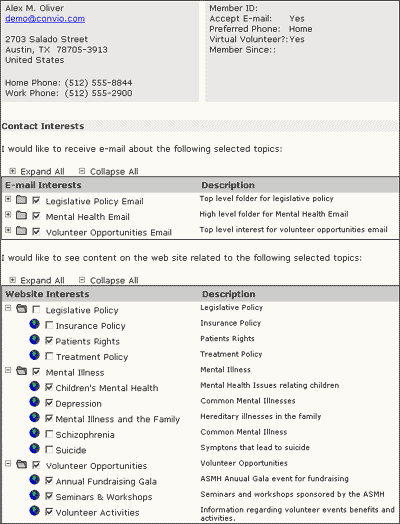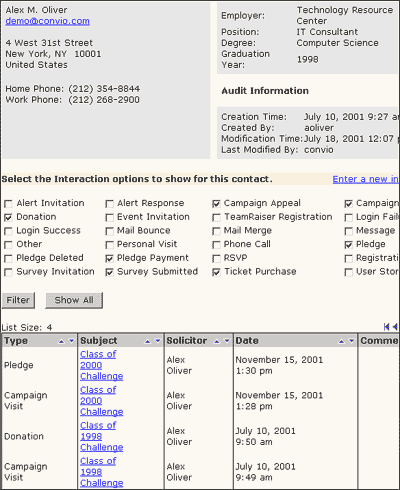|

May 2002 - Issue 13
Online Strategies to Raise Retention Rates
The average nonprofit group retains 50 to 70 percent of donors or members from year to year. This means that with no additional donor acquisition, an organization would deplete its support base to zero within 10 years. Increasing retention rates by even a few points can have a significant financial impact. The Internet can play an important role in boosting retention when utilized to: A) improve communications and steward supporter relationships; and B) reduce renewal costs.
Supporter Retention Is Critical
While there is no substitute for personal interactions, the Internet represents a powerful tool for building strong relationships with constituents en masse. Online strategies to foster this bonding include: 1) acknowledging donors immediately; 2) providing regular updates through email; 3) personalizing communications; and 4) tracking interactions and measuring supporter engagement.
1. Immediate Donor Acknowledgement
Timely acknowledgement and issuance of receipts affect a donor's propensity to give again. Today, when a donor gives a gift, the most efficient groups are able to send an acknowledgement and receipt via paper within a week. But in the online world, donors expect more such as immediate acknowledgement and receipts both on screen and through email. In the United States, the IRS will accept email-based receipts as proof of a gift. In Canada, a PDF-based receipt (secure document) serves as proof.
2. Regular Email Updates
It's simply not enough to thank someone just for a gift. Donors expect the organizations they support to keep them informed through frequent updates. Ongoing communications with donors help to keep an organization's cause top-of-mind, and improve long-term participation and retention rates. Stanford University has found that 50 percent of alumni who receive their email newsletter donate compared to one third who do not.
3. Personalization
Personalizing content to match a constituent's interests further strengthens his relationship with the organization he supports. An easy way to start tailoring communications is to first capture information about constituent interests -- a process commonly referred to as "interest profiling."

Figure 1 Profiling constituent interests through your website
Good tools for interest profiling are questionnaires completed by constituents and track-able Web links that show what content a constituent is clicking on and reviewing. Once a nonprofit has this information, it can personalize email communications and Web content to reflect constituent interests.

Figure 2 Personalized Web content
According to research by Professor Adrian Sergeant, at Henley Management College in Great Britain, nonprofits capable of monitoring the profiles of visitors to their Web sites on average raised 6.5 times more than sites that did not have this functionality.
4. Tracking Interactions and Measuring Engagement
Interacting with constituents online allows nonprofit professionals to track a wealth of information about their behavior and interests. With the right tools, a nonprofit can track the types of emails to which an individual responds and which campaign appeals work; the nonprofit also can collect survey data from constituents.

Figure 3 - Tracking constituent interactions
An organization can then use this information to create marketing segments by running queries, or as background information for personalized appeals. Additionally, the organization can determine whether a constituent's level of engagement is increasing or declining over time, enabling corrective action before it's time for a renewal appeal.
Online Renewal: A Low-Cost Alternative
Making renewal easy and convenient for donors helps improve "customer service" and retention rates. Renewing constituents electronically also saves the mailing costs associated with sending multiple paper-based renewal letters and forms. Renewal through direct mail is costly and burdensome for nonprofit organizations. Typically an organization will send as many as five to six mailings to stimulate renewals, spending 15 to 25 cents per dollar raised. Today's best practices include: 1) providing easy and prompt renewal through email; 2) remembering and immediately acknowledging returning online donors; and 3) tailoring campaigns to donors based on their interests.
1. Prompt renewal through email
Increasingly, email is proving to be a more effective renewal channel than postal mail. It's also a far less costly and intrusive method than telemarketing. Harvard University received a 13 percent response rate to email appeals to alumni versus an 11 percent response rate with direct mail. In similar tests, Stanford University achieved an 11 percent response rate to a personalized email appeal versus a 6 percent response rate to an analogous mail appeal. Moreover, integrated email and direct mail appeals are proving to elicit the best combined response rates.
2. Remember returning donors
Today, most nonprofit Web sites do not make it easy for returning donors to renew. Very few recognize returning donors or pre-fill forms. By contrast, successful commercial Web sites like Expedia.com (the online travel site) or Amazon.com remember returning customers, greet them by name, remember their preferences and pre-fill payment forms so they do not have to re-enter their billing information. In research by Adrian Sergeant, approximately 11 percent of nonprofit Web sites surveyed used technology to remember returning visitors (cookies) and those sites on average raised 10 times as much in funds as sites that did not.
3. Tailoring campaigns to donors
Growing a donor's average gift amount over time is difficult. Sophisticated direct mail programs segment "the asks" according to a donor's giving history. At present, few nonprofit Web sites tailor current campaigns to the specific interests of a donor. Similarly, a nonprofit should segment email appeals. If donors have shown a specific motivation for supporting an organization, combining renewal appeals with specific content based on these interests will increase the likelihood of member renewal.
Conclusion: Retention Strategies in Action
Although it's early in the development of comprehensive data pertaining to online renewal, there's growing evidence that effective online strategies deliver results. Stanford University found that the renewal rate for subscribers to its e-newsletter @Stanford is higher than for non-subscribers 78 percent versus 73 percent, which is significant because variances of just a few percentage points equate to big differences in dollars donated or lost.
For mid-sized nonprofit organizations working with Convio, strategies used to build relationships with donors include: sending frequent, personalized and segmented emails; keeping content fresh and current on the organization's Web site; and making renewal online very simple. For large nonprofits such as The American Society for the Prevention of Cruelty to Animals (ASPCA), these strategies have translated into real results. For The ASPCA, online renewal gifts are 47 percent higher than equivalent direct mail gifts. For Planned Parenthood Federation of America, strategies to enhance online renewal rates have included: sending more frequent communiqu?s through email than historically possible through direct mail; engaging constituents through online surveys; and keeping content fresh on the Member Center.
Although it's not a substitute for personal interaction or stewardship, the Internet does represent a powerful tool for building strong relationships with constituents. Online communications can help any organization sustain dialogue and interaction with donors, supporters, and volunteers while also boosting retention and lowering donor renewal costs.
|





